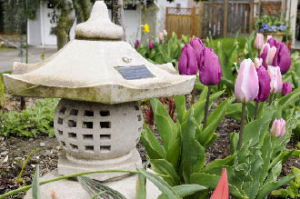The bulbs are in bloom, and it really feels like spring. The urge to be outside is overwhelming, and good gardeners know that now is the time to renew the garden and add new plants. The nurseries receive new shipments every day and the selection grows.
Maybe your garden is just as you wish. Gardens are never static, however. After looking great for several years, plants can easily become overgrown or invaded by weeds. Look carefully. Some plants, usually the trees and larger shrubs, will remain. It is hard for any gardener to take out a tree or shrub, but if they were originally planted too closely or in the wrong place, cutting out the weakest will give the others a chance to attain their full potential. Large trees and shrubs can be moved, but that is best left to professionals. Careful pruning of the rest will give them light and air. Be sure to leave pruning until dormancy on any shrubs or trees that have leafed out.
Sometimes, plants we carefully added to our gardens become thugs. The lovely Japanese Anemone, for instance, can become a tyrant and will take years to remove if the plant has been in place for several years. Ajuga can stealthily invade the lawn. Sweet woodruff and Oregon oxalis never stop spreading. When these take over, the monumental task of yanking them out must prevail. For some, you may need to cut the stems to the last few leaves and carefully paint with a small brush those remaining with full-strength Roundup, making sure to touch the cut stem. Don’t spray unless it is the last resort, as it will kill everything. Even well-behaved plants such as daylilies can outgrow their allotted space and need to be divided. This is a great time to correct these problems.
Sometimes, all that is necessary to make a bed look wonderful is to move or remove some of the plants. If there are too many unrelated plants, it can look rather like multicolored polka dots. Rearranging them according to color or plant type can vastly improve the overall appearance. If they’re too big, divide them and give some away or pot up for garden sales. Spring is a great time to divide plants.
This might be the year to help the drain-off into our lakes and rivers by creating a rain garden. Instead of fighting the drainage that wrecks lawns and makes muddy paths, a small boggy area created purposefully will turn a headache into a joy.
To do this, walk across your yard to find the wettest spot. Dig down about 12 inches and layer about two inches of sand at the bottom, creating an attractively shaped bed. Fill the area with the best compost you can find, mixing in some of the original soil. Plant the area with some of the many plants that like moist to wet feet. There are trees such as ornamental willows, Amelanchier and even Western Red Cedar, if you have the room for a 75-foot tree. Shrubs such as Red Twig Dogwood or Red Current are lovely, and many perennials will do well with lots of moisture. Ligularia, Rogersia and Gunnera all boast large tropical-looking leaves and do best with moist soil in partial shade to full sun. Hostas and ferns add interesting leaf and texture to the shaded areas, and Mimulus, Japanese Primrose and Spiderwort (Tradescantia) add bright flowers and bloom well with little sun.
Although there is much work required in the garden just now, it is spring. The bulbs are blooming and summer will soon be here.
Linda Stephens-Urbaniak can be reached at Lindagardenlady@speakeasy.net.


